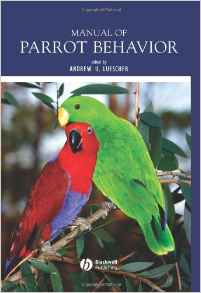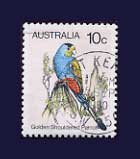
Manual of Parrot Behaviour
Andrew Luescher has edited a selection of articles looking at parrot behaviour from different specialists, giving the reader a range of perspectives on the relationship between parrots and humans. Contributors include lab researchers, vets, and behaviourists. Manual of Parrot Behaviour is not a thorough investigation into the behaviour of wild parrots of different species, though there is a lot of information in natural parrot behaviour in the book. Its strength is as an exploration of how parrots behave when they come into contact with humans in different roles, and how humans in different roles perceive parrots. There are also chapters geared to helping owners to prevent their parrots from developing unwanted habits (like biting and continual screeching!) or cope with birds that have distressing habits. However, again, this book isn’t primarily geared to parrot owners.
Who is likely to find Manual of Parrot Behaviour an interesting read? Probably anyone interested in the behaviour of animals kept by humans, and how humans treat and perceive animals, including vets, and students of animal behaviour and anthrozoology.
A key issue for people concerned with parrots in captivity is that they aren’t truly domesticated, or geared for living with humans, in the way that cats, dogs, and even ferrets are. Domestication is a long-term process whereby animals undergo changes over generations, until their behaviour is altered enough for them to be a comfortable ‘fit’ with that of humans. Some parrots in captivity are wild-caught, and obviously, wild animals don’t take kindly to being deprived of their companions and their freedom. However, even parrots born in captivity and tamed by humans still retain the characteristics of wild parrots. This means both that parrots often upset their owners by behaving like parrots, and that parrots can be driven insane by humans who fail to recognize their need to express their natural behaviour.
There’s now general recognition that pets should be able to behave naturally, within reason, but this message hasn’t been taken on board by all the contributors to this book. The issues here are similar to those raised by training dolphins to perform tricks to amuse humans. However ‘kind’ the training methods used, if the training is simply to get the parrot to amuse humans, and doesn’t take into account a parrot’s need to express its natural behaviour, then it can’t really be called ‘kind’. This is a particular problem with large parrots, especially those kept isolated from their own kind.
When captive parrots can’t express their natural behaviour, they tend to develop abnormal behaviours, not seen among wild parrots. This book details a number of distressing abnormal habits, including feather-plucking and mindless, repetitive movements. The ‘solutions’ offered by some contributors, such as medication, seem to miss the point, that parrots aren’t designed to be companion animals, and if humans take them on, whether as pet owners, or scientific researchers, they have a responsibility to ensure that parrots can behave like parrots as far as possible.
So, while Manual of Parrot Behaviour is a fascinating book, it won’t tell you all you need to know about parrot behaviour. You’ll need to supplement it with more in-depth accounts of the behaviour of wild parrots of different species. This in turn leads to questions about how we humans relate to pets, and how human behaviour can be a little weird!



